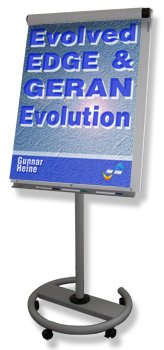 Evolved EDGE & GERAN Evolution
Evolved EDGE & GERAN Evolution
[2-day course, Euro 2,350.- (net) per participant]
 Training Course Description
Training Course Description

- This training course addresses the needs of design and test engineers both at vendors and operators to understand in detail the contents and implications of the next phases of GERAN, usually referred to as "Evolved EDGE" or GERAN-evolution.
- In that respect, the training course starts with an assessment as to where GSM and GERAN stand today compared to 1991.
- The training course continues with the detailed description and analysis of the various proposed changes which are commonly referred to as EDGE phase 2, evolved EDGE or as GERAN-evolution.
- This chapter includes but is not limited to the description of techniques like downlink and uplink multicarrier, HOMTC, MORE, HUGE, RED HOT and LATRED. Each description is accompanied by a detailed analysis of the related pros and cons and implementation implications.
- The focus of the following chapters is the detailed description as to how features like downlink multicarrier, flexible timeslot assignment, HUGE, RED HOT (EGPRS2) and RL-TBF have been integrated into the release 7 series of specifications.
Please click here for a detailed Table of Contents (ToC)
Some of your questions that will be answered
- What is the motivation of GERAN-evolution and who steers it?
- How does GERAN differ from the envisaged 4G-mobile networks and can it be evolved to offer similar services?
- How do technology improvements like HOMTC, multi carrier, higher symbol rates, RTTI or VSRB operate?
- What are the differences between 16-QAM- and 16-APK-modulation?
- Which new slot and burst formats have been investigated?
- How many RF-carriers are supported in uplink and downlink direction with GERAN-Evolution?
- What is "Flexible Timeslot Assignment"?
- Which performance improvements are achieved through multicarrier operation?
- Which performance improvements do HUGE and RED HOT offer?
- How do HUGE and RED HOT cope with the presented liabilities of higher order modulation schemes?
- What is bit swapping and how is it used in HUGE and RED HOT?
- Which new burst formats and which new coding schemes (DAS, UAS, DBS and UBS) have been defined for HUGE and RED HOT?
- Which options for latency reduction have been incorporated into Release 7 for the so called RL-TBF operation?
- How can mobile stations operating in BTTI-mode be multiplexed with mobile stations operating in RTTI-mode?
- How does a mobile station receive USF-allocations during RL-TBF operation?
- How is a PAN-Field transmitted?
- What is MCS-0 and why was it introduced?
- What is RLC non-persistent-mode of operation and how does it operate?
 Who should attend this class?
Who should attend this class?
- Design and test engineers who shall be on track with the current state of technology.
- Managers who needs to understand the details and implications of GERAN evolution.
 Pre-Requisites
Pre-Requisites
- The student must possess detailed understanding of GSM- and EGPRS-technology, obtained during the design or test of the related equipment.
 Training Course Target
Training Course Target
- The student is enabled to implement or test the related technology updates within handsets or base stations.
- The student will be aware of the current state of Evolved EDGE and the integration of the related techniques into the specifications.
- In addition the student will understand the implications of each technique in detail.
 Training Course Duration
Training Course Duration
- 2 days
v1.700
ℹ️ Try out the updated search below!
Search:
More Info:
Detailed ToC of this training course
Schedule of this training course
Buy this book
Buy this book as eBook
INACON eBooks
Please have a look at our full offer

